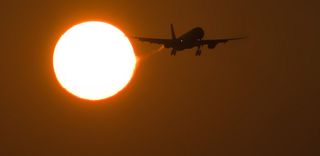
Are Solar Storms a True Health Threat?

This article was originally published at The Conversation. The publication contributed the article to Live Science's Expert Voices: Op-Ed & Insights.
Space weather impacts many modern-day technologies. But one of the most concerning – and least reported – space weather effects is the increased radiation exposure to passengers on commercial long-distance flights during so-called “solar radiation storms”.
The NASA-funded Nowcast of Atmospheric Ionizing Radiation System (NAIRAS) is the computer system tasked with providing a real-time data-driven climatology of the aviation radiation environment.
Recently, a series of papers published in the journal Space Weather estimate that when NAIRAS was turned off during the US government shutdown last year – which went into effect just as a solar radiation storm began – 500,000 people received increased radiation doses.
It has also been estimated that this event is likely to eventually result in four cancer-related deaths.
What is a solar radiation storm?
Disturbances on the surface of the sun are commonly the cause of geomagnetic disturbances here on Earth; such as power grid faults/failures and increased errors in GPS navigation and positioning.
Associated with some of these solar disturbances is the ejection of extremely fast plasma into the solar wind that, when aimed directly towards the Earth, causes the onset of increased geomagnetic and ionospheric activity.
Sign up for the Live Science daily newsletter now
Get the world’s most fascinating discoveries delivered straight to your inbox.
The Earth-bound solar energetic particles ejected into the solar wind eventually penetrate into the Earth’s magnetosphere.
When inside the magnetosphere, they orbit the planet across the Earth’s magnetic field lines until they are scattered by various complicated magnetospheric processes and interactions.
Once scattered, these solar particles then travel down the magnetic field lines until they impact the Earth’s upper atmosphere, where they are effectively absorbed.
The penetration depth of these particles primarily depends on their kinetic energy, which is governed by their mass and velocity.
The less energetic particles are stopped by the Earth’s atmosphere typically between 100 and 400km altitude, causing the well-known aurora in the northern and southern high-latitude regions.
The atmosphere increases in density exponentially as the particle falls. This normally prevents particles penetrating to lower altitudes where they are harmful to living organisms.
The more energetic particles, called “solar energetic particles”, caused by these solar disturbances can penetrate to below 10km, near the cruising altitudes of commercial flights.
During such events, the danger posed by the increased radiation levels is easily averted by decreasing the cruising altitudes of the aircraft. Pilots can also divert their flight paths to areas less affected by the increased radiation levels (more equatorward latitudes).
Several chest X-rays worth of radiation
The aviation radiation monitoring performed in real-time by computer systems such as NAIRAS can effectively be used to issue such warnings to aircraft.
This will help remove the threat posed to hundreds of thousands of people across the globe during such space weather events.
The geomagnetic activity levels associated with the solar radiation storm that occurred during the US government shutdown were only minor (a minimum Dst of -54nT).
This means the technologies normally classified as being vulnerable to extreme space weather events are not likely to have been significantly affected.
The solar energetic particle levels observed by geostationary satellites classifies this as an S2 solar radiation storm. It lasted more than 24 hours, and took about four days to fully subside (see video below).
Some controversy exists around the exact method used by the scientists of the first study into this event. There has been doubt around the estimation of the number of eventual cancer fatalities related to this solar radiation storm.
Even though the radiation levels air travellers were exposed to during this event are much higher than they might have been had an appropriate warning been issued, they were still comparatively low – on par with the dose that one would receive from a number of chest X-rays.
Arguments put forward by some researchers err on the side of caution. They indicate that some people who would be considered more vulnerable to increased radiation exposure (such as frequent flyers and unborn children) should have access to this radiation monitoring information.
This would enable them to make educated decisions about appropriate air travel times in much the same way that non-urgent X-rays may be postponed during pregnancy.
Other researchers have erred on the opposite side, with the view that the radiation doses during this event were too small to be considered a serious threat.
Independent of whether or not this particular space weather event exposed air travellers to dangerous levels of radiation, these studies are in clear agreement that increasing radiation monitoring is a must in the future.
This is especially important for the aviation industry, and the provision of such information must not be hindered by short-term political partisan interests.
Brett Carter receives funding from the Victorian Postdoctoral Research Fellowship Program.
This article was originally published on The Conversation. Read the original article. Follow all of the Expert Voices issues and debates — and become part of the discussion — on Facebook, Twitter and Google +. The views expressed are those of the author and do not necessarily reflect the views of the publisher. This version of the article was originally published on Live Science.
